by Lisa Cooke | Apr 14, 2017 | 01 What's New, Records & databases
U.S. land entry case files are now free to browse at FamilySearch. We give you a link to a free index to those–and MORE new and updated records for Argentina, Australia, England, France, Germany, Ireland, the Netherlands, New Zealand, Scotland, and other U.S. collections (Crimean War photos, Illinois birth certificates, and more).
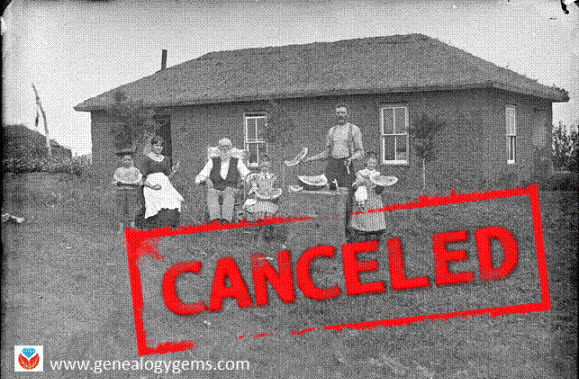
Featured: U.S. Land Entry Case Files
Over a quarter million record images have been added to the free FamilySearch database of United States, Cancelled, Relinquished, or Rejected Land Entry Case Files, 1861-1932. This collection gives researchers access to browsable images of case files for those who unsuccessfully applied for homesteads (such as the one shown above; click the image to see its citation), mining claims, and land pre-emptions. Even better–the National Archives website hosts a name index to speed along your search of the browsable records at FamilySearch!
According to a National Archives description of the original collection, “A file may contain the original entry application, correspondence between the officials of the Lincoln Land Office and the GLO in Washington, D.C., receipts for fees paid, public notices, affidavits and witness statements, proof of military service, the entryman’s naturalization records, and documents concerning the cancellation or relinquishment of the entry.”
This collection of Land Entry Case Files includes Kansas land offices at Dodge City and Topeka and Nebraska land offices at Alliance, Broken Bow, Lincoln, North Platte, O’Neill, and Valentine. More records will be forthcoming.
Argentina—Church records
Over a quarter million indexed names have been added to a free FamilySearch collection of Catholic church records for Entre Rios, Argentina (1764-1983). Also noteworthy are over 118,000 record images recently added to FamilySearch’s Argentina, Corrientes, Catholic Church Records, 1734-1977.
Australia—Emigrants
Nearly 170,000 indexed names have been added to the free FamilySearch collection, Australia, Victoria, Outward Passenger Lists, 1852-1924.
England—Newspapers and Wiltshire
The British Newspaper Archive recently announced it now has a title online for every county in England. (Click here to learn more.) They’ve also updated several London titles and added two new ones, among them the North London News and West London Observer.
Findmypast.com has recently added more than 4.5 million records that can help those searching for ancestors in Wiltshire, in southwest England:
France–Census records
New indexes to French censuses for 1876-1906 are now free at FamilySearch:
- France, Côtes-d’Armor, Census, 1876
- France, Côtes-d’Armor, Census, 1906
- France, Côtes-d’Armor, Census, 1891
- France, Hérault, Census, 1876
- France, Hérault, Census, 1906
- France, Nord, Census, 1906
Germany–Church and Family Tables
Ancestry.com has published two new collections of German Lutheran church records. Note that the time periods overlap, so try searching them both:
Also new on the site is a collection called Baden-Württemberg, Germany, Family Tables, 1550-1985. A tip from the collection description: “Use the browse fields to sort through the images by City or District and Description of records.”
Ireland—Newspapers
Nearly a million new articles have been added to Findmypast’s enormous collection of digitized Irish newspapers. This unique collection now hosts more than 35 million articles.
Netherlands
Over a million indexed records have been added to a miscellaneous archival index for the Netherlands at FamilySearch. If you’ve got Dutch roots, check it out–it’s free.
New Zealand—Probate records
Over a quarter million browsable record images have been added to a free FamilySearch collection of New Zealand probate records.
Scotland—Catholic records
As promised, Findmypast continues to expand its Catholic Heritage Archive. Recent additions include baptisms, congregational records, marriages, and burials for Scotland.
U.S.–Crimean War
A collection of Crimean War photographs from the Library of Congress is free to search online, and is the subject of a recent article on the Library of Congress blog: “Witness to History.”
U.S.—Illinois—Cook Co
Got relatives from Chicago, Illinois? Perhaps they’re among more than a quarter million newly-indexed names in Illinois, Cook County, Birth Certificates, 1871-1940, free to search at FamilySearch.
U.S.—Kentucky
Newspapers.com has added Louisville, Kentucky’s Courier-Journal to its collections of digitized newspapers. Basic subscribers have access to just shy of 100 years’ worth of issues (1830-1922) and Publisher Extra subscribers also may access more recent years (1923-2016).
U.S.—Massachusetts
FamilySearch has added 1.3 million names to its free collection, Massachusetts, Boston Crew Lists, 1917-1943.
U.S.—Michigan
A new online database of The Michigan Daily brings more than 23,000 issues digitally searchable. This is the student newspaper of the University of Michigan. The newspaper archive spans 125 years: 1890-2014. Click here to search it for free.
Google your way to MORE genealogy records like these
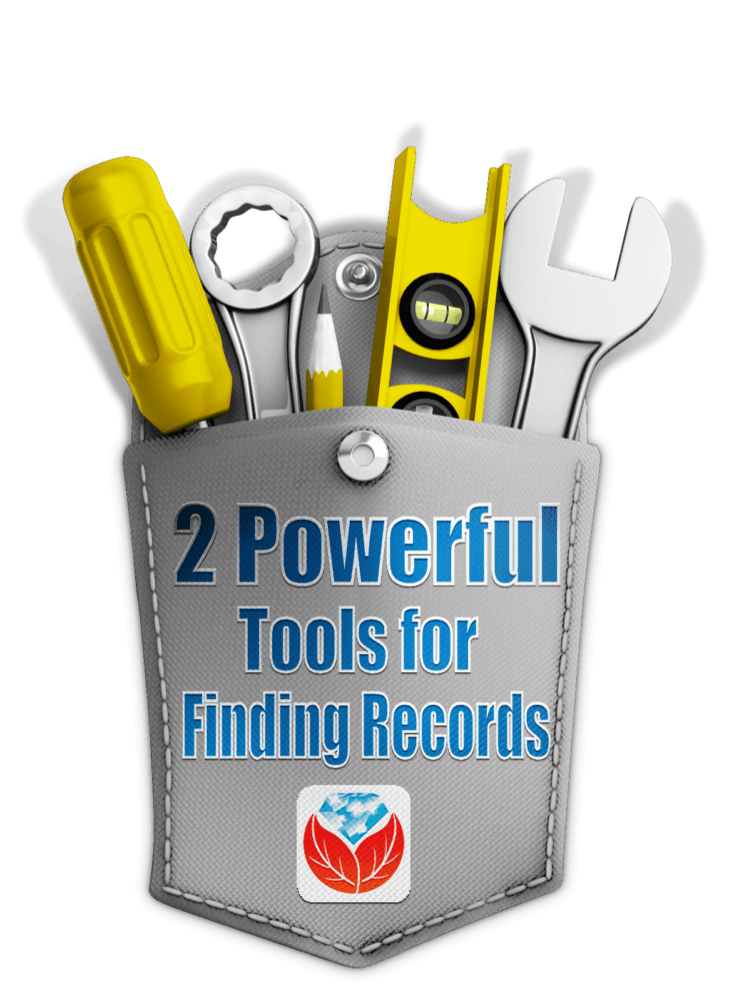
Wish you could find similar records for another time or place? Use Google search strategies to target the record types, places and even a specific range of years. You can even search for digitized photographs on Google! Click here to read more about Googling old records online.
Disclosure: This article contains affiliate links and Genealogy Gems will be compensated if you make a purchase after clicking on these links (at no additional cost to you). Thank you for supporting Genealogy Gems!
by Diahan Southard | Apr 29, 2017 | 01 What's New, Genealogy Giants Websites, Records & databases |
Social Security Death Index (SSDI) search is not necessarily as straight forward as you might think. We’re going to explore what SSDI records are, their range of availability, and how they compare across the Genealogy Giants records websites.
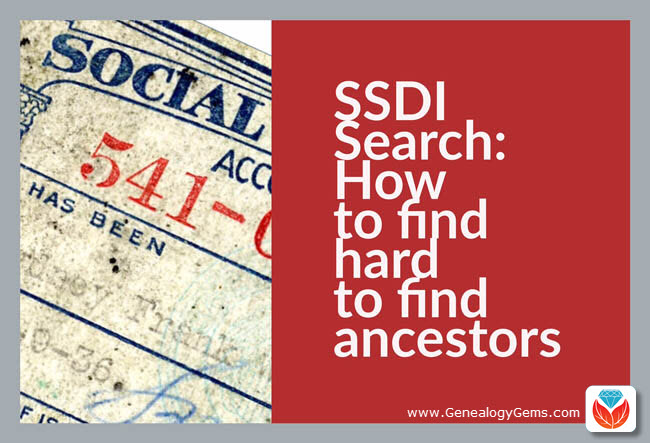
If you’ve been dabbling in genealogy research for a while, then you are very likely familiar with the Social Security Death Index, more commonly referred to as the SSDI. But even experienced researchers have questions, like the one that Marti sent me recently:
From Marti in Texas:
Hi Lisa!!
Thank you so much for all your helpful resources on your website!! I just listened to the SSDI Working Backwards podcast episode (Family History: Genealogy Made Easy episode 3) and my grandparents passed away in 2012 and 2014. Do you know when the last time the index has been updated, I cannot locate them.
Thank you so much!!
This two-fold question is a good one. While many genealogical record sets have privacy laws that dramatically restrict more recent records from being available, the SSDI is not one of them. But even if the records are available, there may still be times when we have trouble locating our relatives.
Whenever you run into a road block finding ancestors in a record collection, do what good detectives do, and go back to the beginning. In this case, let’s learn more about the collection itself.
Social Security Death Index Background
The Social Security Act was signed into law in 1935 by President Franklin Roosevelt. By 1937, more than 30 million Americans had registered. Today, the Death Master File from the Social Security Administration contains around 90 million records of deaths and they are publicly available online.
Some data goes as far back as 1937, but most of the information included in the SSDI dates from 1962. This is because the Social Security Administration began to use a computer database for processing requests for benefits in 1962. Some of the earlier records back to 1937 have not been added.
It’s important to know that the SSDI does not have a death record for everyone. It’s also very possible that you may occasionally find an error here and there if something was reported incorrectly. But don’t let that stop you from tapping into this major resource! It’s a wonderful alternative source for finding people who were counted in the 1890 census (which was unfortunately mostly destroyed) because they may still appear in the SSDI. Also, those who were born before vital records registration in their home state began, may also show up. Remember, working folks just had to live past 1937 to have been possibly included. That means some people could have been born sometime in the late 1800s.
Now that we have a handle on the history of the SSDI, let’s look at who has it and how recent their records are.
Where to Find the SSDI
The Social Security Death Index (SSDI) is available on all of the ‘big 4’ genealogy records websites, which we here at Genealogy Gems refer to as the “Genealogy Giants.” The links below will take you directly to the SSDI search page for each.
- FamilySearch
(Current as of February 28, 2014)
- Ancestry
(1935-2014)
- MyHeritage
(It is not stated how current the database is, but a search for 2014 did retrieve results)
- Findmypast
(No dates or citation provided, but a search for people who died in 2014 did retrieve results)
In Marti’s case, she will want to search every single one of these websites for her ancestors. The good news is that they all appear to be up-to-date, but that doesn’t mean they are all exactly the same. The same collection of genealogy records can appear differently from site to site for a number of reasons such as accidental omissions, variations in the power of their search engine, differences between indexers and scanners, and Optical Character Recognition (OCR) inaccuracies. These may or may not affect the SSDI, but the point is that you can’t go wrong searching each one of the Genealogy Giants just in case. And since SSDI search can be conducted for free at all of the Genealogy Giants, it doesn’t cost you anything to do so.
A quick way to find all of the websites that include the SSDI is to Google SSDI genealogy. Here’s a link to the results.
SSDI Search Head-to-Head Comparison
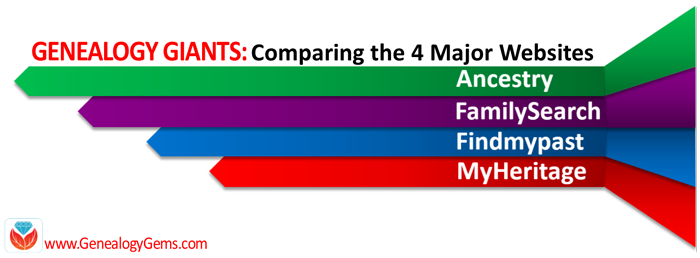 Another excellent reason to search the SSDI on multiple websites is that each website displays the information a little differently. And as you can see from the chart below, when it comes to the Genealogy Giants, there are definitely differences.
Another excellent reason to search the SSDI on multiple websites is that each website displays the information a little differently. And as you can see from the chart below, when it comes to the Genealogy Giants, there are definitely differences.
It’s interesting to note that Ancestry is the only website that provides information about the year that the Social Security number was issued. It isn’t exact, but it’s more than the others offered in my search for Alfred H. Sporan.
The differences between the 4 major websites can be sometimes subtle or quite dramatic. Understanding their strengths and weaknesses, as well as free versus subscription offerings, is key to successful research that is both efficient and cost-effective.
The quick reference guide Genealogy Giants: Comparing the 4 Major Websites is a must-have for anyone serious about getting the most out of free and paid subscriptions.
The author of this 4-page full-color cheat sheet, Sunny Morton, is Contributing Editor here at Genealogy Gems, and she’s packed this guide with everything you would ever want to know, and many things you probably didn’t know that you needed to know. You can
pick up your copy here in our store.
SSDI Search and Beyond
There is another database at Ancestry that is worth keeping your eye on. It’s called the U.S. Social Security Applications and Claims Index and it shouldn’t be missed! Currently, this covers 1936-2007, but who knows, they may update it in the future. It includes even more information. It was first released in 2015. Read more about it here at Genealogy Gems.
Gems: Share Your SSDI Search Experience!

I invite you to take a moment to share your SSDI search experience in the comments below. Have you had any surprises? Did you find a difference between the records found at different websites? We want to hear your story because we all benefit from each other’s experiences.
Disclosure: This article contains affiliate links and Genealogy Gems will be compensated if you make a purchase after clicking on these links (at no additional cost to you). Thank you for supporting Genealogy Gems!
by Lisa Cooke | Apr 8, 2017 | 01 What's New, DIY Family History, Video
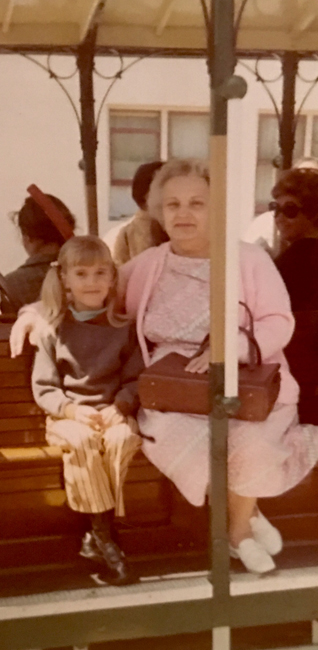 When I got up this morning, my mind was on getting up and out the door to my grandson Davy’s baseball game. But I couldn’t help but entertain this nagging feeling that there was something else special about this day.
When I got up this morning, my mind was on getting up and out the door to my grandson Davy’s baseball game. But I couldn’t help but entertain this nagging feeling that there was something else special about this day.
In the car after the game, wind-swept and with a bit of powdered sugar on my blouse from the funnel cake Davy’s younger brother Joey and I shared, it dawned on me: today is Grandma’s birthday.
Grandma Burkett passed away over 31 years ago, and yet she’s always close with me. I feel her cheering me on in my genealogical searches, and reminding me that there is no contest between sleeping in and attending a grandchild’s baseball game. She was my role model for what a Grandma should be. Even though my grandchildren call me Sha Sha, I hope my grandkids feel my efforts and know that they are loved, as I was loved by her.
As Bill drove us back out to our home in the country, I pulled my phone out of my purse, and decided to create a video birthday card to Grandma.
(Full disclosure: I’m going to share with you my go-to tool of choice. Animoto is a sponsor of The Genealogy Gems Podcast, however, I personally use it because I think it’s fantastic.)
Animoto is my go-to tool of choice. With a tap of the app, I selected a theme and music that I thought would suit it nicely, (that’s the part that takes me the longest because I love their varied selection of tunes!).

Next I tapped to select about 14 photos sitting in my Dropbox account.
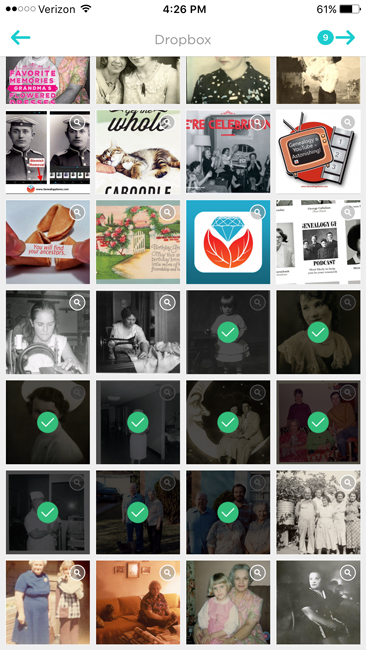
Then I added a title card at the beginning and the end, and tapped Preview. In about 30 seconds I had a finished video, complete with transitions perfectly timed to the music. One more tap of Save & Produce Video and my HD quality video was rendered so I could upload it to Facebook to share with my family and the world.
Then I quickly downloaded an HD copy for myself. The ability to download your HD quality video is one of the really unique features of Animoto, and one you should wholeheartedly take advantage of. Unless you have that copy saved to your own computer, (and OF COURSE your computer is backed up, right? If not, click here) you can never be sure that it won’t be lost over time.
There’s always enough to pay tribute to those who inspire us, particularly when creating videos like these is so fast and easy. Who inspires you? I would love to hear! Please leave your comment below.
Thank you Grandma!
Lisa
P.S. Mother’s Day is coming up. And that brings to mind another woman who inspires me, my daughter and mother-to-be, Vienna. I feel another video coming on! 😉
by Lisa Cooke | Mar 31, 2017 | 01 What's New, Craft & Displays, Holidays
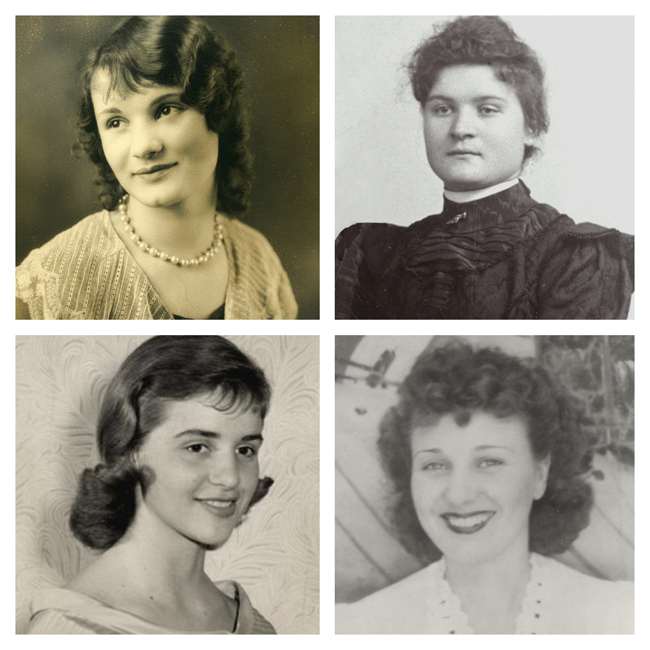 It’s the last day of March, so it must be time to start thinking about Christmas, right?
It’s the last day of March, so it must be time to start thinking about Christmas, right?
OK, so you may not be thinking about your next Christmas craft project or gift-giving. But March has been Women’s History month and I’ve got a fun and easy craft project for you that will honor your female ancestors, help you do a bit of Spring cleaning of your stashes of left over fabric, and put you well ahead of the game when it comes to holiday prep.
Follow along with me in the video below as I piece together a crazy quilt Christmas stocking.
Familiar Female Faces
This stocking not only possesses a nostalgic flare with its Victorian-era crazy quilt design and embroidery, but it’s also brimming with familiar female faces from my family tree. Gathering together as many photos as I could of the women that I directly descend from was a fun challenge. I scoured old photo albums, searched online family trees, and put the word out to family members to make sure I had every available image. I was pleasantly surprised at how many I came up with.
Not Just for Stockings
This crafty idea certainly isn’t limited to Christmas stockings. You could translate this into a wall hanging, or even a full-size bed quilt. Make one as a gift, and it will surely be handed down the family lines for generations as a treasured heirloom.
Create a Video Story of Your Creation
I made this video with Animoto, a web and mobile app that makes this job of video creation oh, so easy! And it got me to thinking how lovely it would be to give a “bonus” gift of video to the recipient of this family history present.
-
Re-purpose the Photos – since you’ve already pulled out the photos to create the transfer images, why not drop them into Animoto? Add your memories, poems they wrote, and any other tidbits that help their legacy shine through. Sprinkle with a bit of music (Animoto has loads of songs to choose from), and in minutes you can create a short tribute video to the women in your tree.
-
Document the Project – Grab your smartphone and snap pictures and videos during the process of creating the stocking (or other form of this project). Toss your photos and videos into Animoto, add personalized comments, and you’ll have a sweet video to accompany the gift. It will show how you poured love into every stitch! (Ah! What I wouldn’t give for such a video of my Grandma sewing the lovely items I treasure today!)
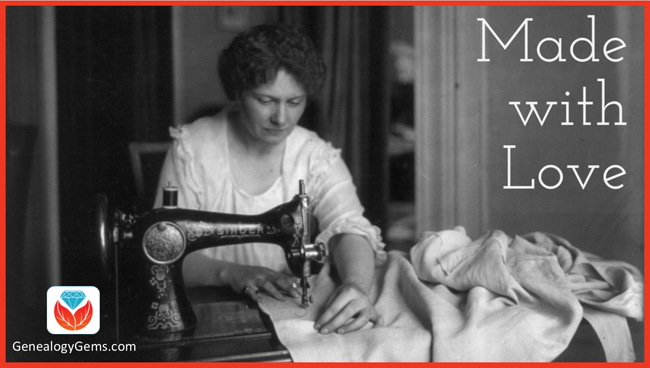
(Full disclosure: This post contains affiliate links and I will be compensated if you make a purchase after clicking on my links. I appreciate you using these links because that compensation helps make the Genealogy Gems blog possible. Thank you!)
Animoto is a trusted sponsor of the Genealogy Gems Podcast.




 Another excellent reason to search the SSDI on multiple websites is that each website displays the information a little differently. And as you can see from the chart below, when it comes to the Genealogy Giants, there are definitely differences.
Another excellent reason to search the SSDI on multiple websites is that each website displays the information a little differently. And as you can see from the chart below, when it comes to the Genealogy Giants, there are definitely differences.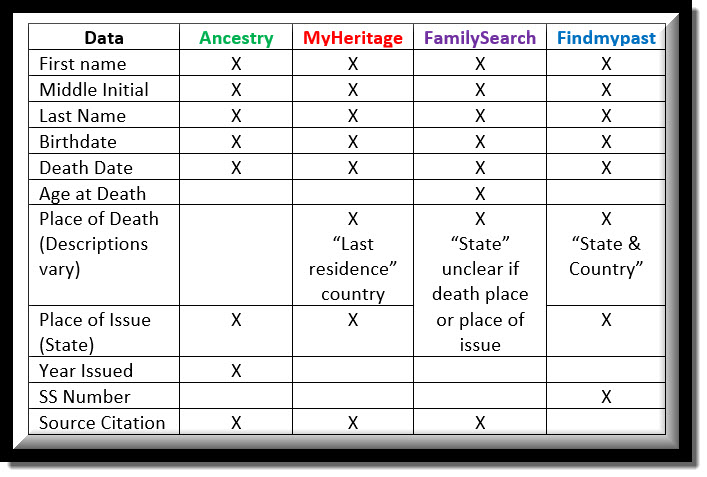
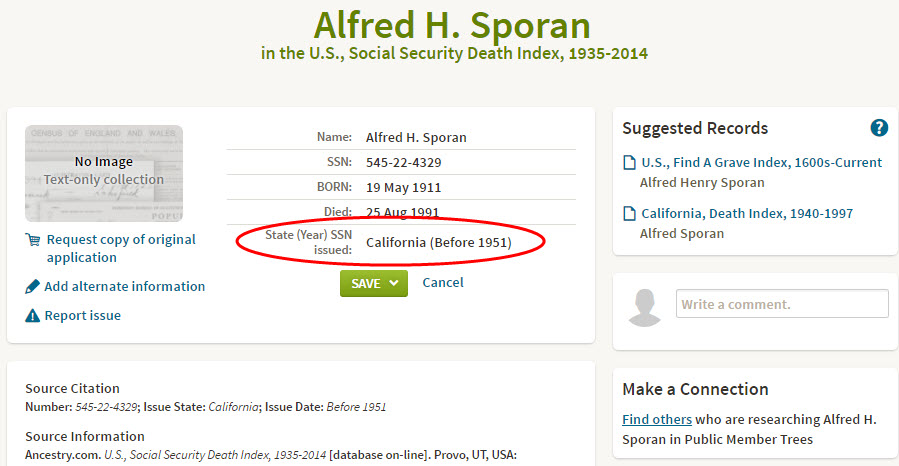


 When I got up this morning, my mind was on getting up and out the door to my grandson Davy’s baseball game. But I couldn’t help but entertain this nagging feeling that there was something else special about this day.
When I got up this morning, my mind was on getting up and out the door to my grandson Davy’s baseball game. But I couldn’t help but entertain this nagging feeling that there was something else special about this day.

 It’s the last day of March, so it must be time to start thinking about Christmas, right?
It’s the last day of March, so it must be time to start thinking about Christmas, right?



